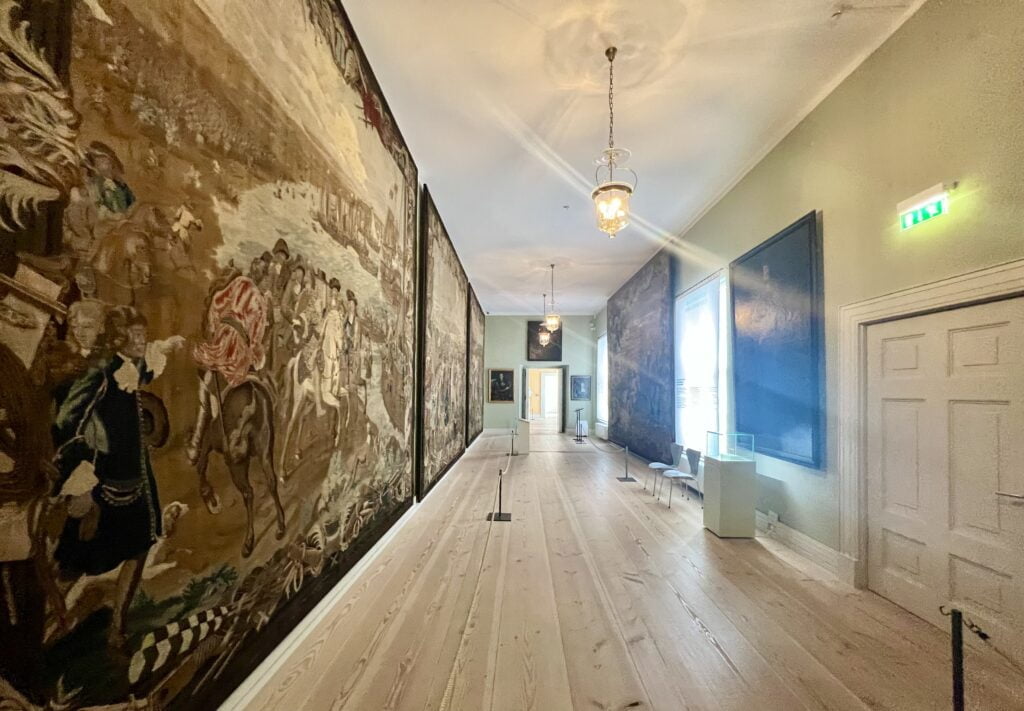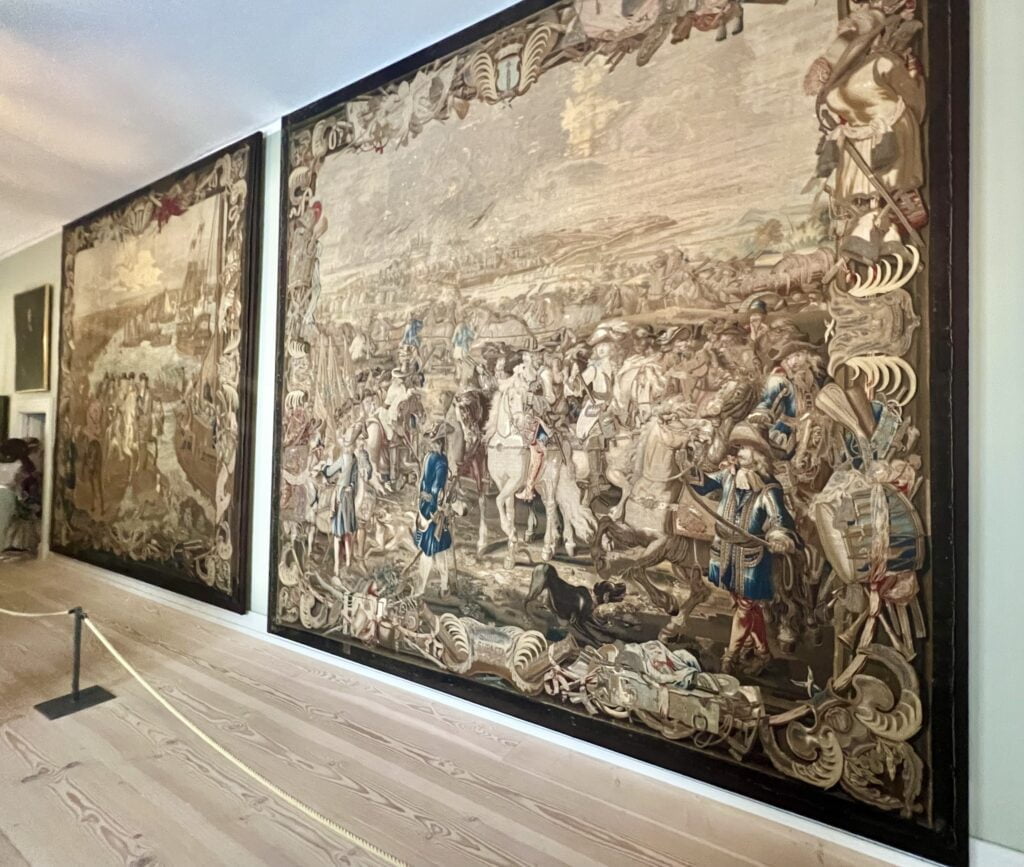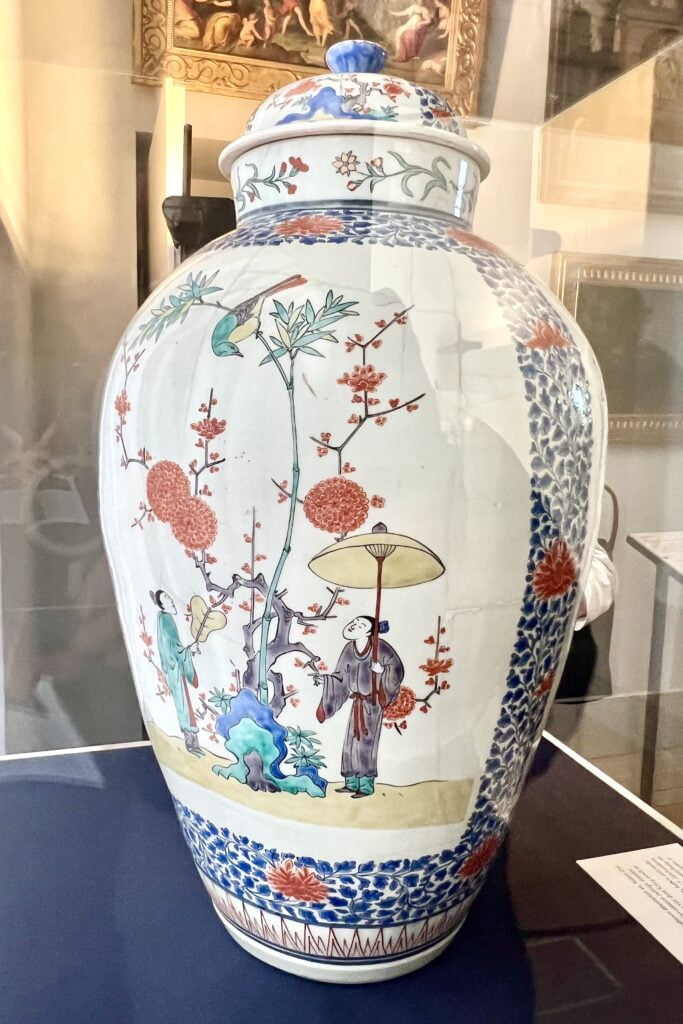The Oriental Ceramics Society tour of Berlin was held at the beginning of the summer and was one of the most interesting trips that I had been on with the Society. There was a diverse group of 24 of us and we were fortunate to see behind the scenes of some of the most significant Royal palaces and museums in the Berlin area over a four day period.
Schloss Oranienburg – Tuesday 30 May

Schloss Oranienburg was our first stop on the opening day of the tour. It was built from 1651 to 1655 on the site of an earlier hunting lodge by Louise Henriette of Orange-Nassau, the first wife of Frederick William, Elector of Brandenburg.
We started with a tour of the state rooms which included some magnificent late 17th century tapestries by Pierre Mercier in Berlin depicting some of the Grand Elector’s historical battles. On our way to the porcelain cabinet we passed a really rare Kakiemon jar and cover, made at the Arita factories in the 17th century. It depicted two ladies under bamboo and prunus, one holding a parasol and the other a fan.



The highlight of the visit was the porcelain cabinet, a room that originally displayed many of the 17th and 18th century Chinese and Japanese porcelains from the collections of the Brandenburg electors and electresses. The idea of a porcelain room or cabinet was very much the fashion in Europe from the mid 17th to the mid 18th century. The room at Oranienburg was created by Frederick I (1657-1713) between 1688-1695 after he inherited his mother’s collection of Chinese and Japanese porcelain. The construction of the room was based on designs by Christof Pitzler, a pupil of Jean Marot 1.
The room has been partly re-created and features the same type of gilt wood pyramids or etageres that would have originally been used. The porcelain would have been placed on the walls and columns to enhance the architectural features of the room. 2. The columns and the walls were covered with porcelain and expensive mirrors, the latter which would have reflected the blue and white. ‘No paintings, textiles or lacquer disturbed this confusing play between reality and illusion’. 3.
On one wall, one of these pyramids is surrounded with an enlarged print to give one the impression of what the room would have originally looked like. I have also attached images below of how the room would have looked from the engraving by Jean Baptiste Broebes in 1733 and a contemporary computer generated reconstruction of how the room would look once completed. It is certainly a sumptuous and showy display designed to impress the viewer.









In the centre of the ceiling of the porcelain room at Oranienburg is a large circular allegorical painting, by Augustin Teerwesten. It depicts the figure Orania seated in the clouds in an orange dress, surrounded by and holding pieces of blue and white porcelain.

The handling session and the subsequent ones over the next three days, was convened by the highly knowledgeable and practicing potter Anette Mertens. Her experience and insights into the manufacturing of the porcelain was of great interest to the group during the trip.






Lempertz Handling Session and Presentation with the German Association of East Asian Art
After a brief break for lunch we met at the Berlin office of Lempertz auction house for a handling session and a presentation on the 1929 China exhibition, held at the Prussian Academy of Art in Berlin. The talk was given by Dr Herbert Butz, the retired former senior curator at the Museum of Asian Art, East Asian Art Collection, National Museums in Berlin.
He gave an interesting introduction to the exhibition, which was one of the first of its kind in Europe. Dr Butz cited some of the English collectors from the Oriental Ceramics Society that had attended and had assisted in the exhibition, such as Sir Percival David, George Eumorfopoulos and Oscar Raphael.






We handled a number of pieces for their forthcoming 21 June auction in their main gallery. It was a bright sunny afternoon and the light pouring through their large windows really helped in the viewing of the pieces.










Kunstgewerbemuseum (Museum for Art and Design) – Wednesday 31 May
The second day started with a tour of the Kunstgewerbemuseum (the Museum of Decorative Arts). The building is situated in Matthäikirchplatz on the edge of West Berlin. It is part of the Kultureforum, a collection of cultural buildings that were built in the 1950s and 1960s and was founded in 1868 as a teaching institute and public museum. After World War II, the collection was split between East and West Berlin. The Eastern collection moved to Köpenick Palace in 1963 and the Western to Charlottenburg Palace and then into its current building in 1985.

The entrance and foyer was quite unexpected in that it was a rather cramped and brutalist modern space, however, this quickly opened out to spacious well lit galleries comprising some significant collections of European and Asian decorative art.


The highlight of the Asian collection on display was the group of Chinese works of art that were put together by Max Von Brandt (1835-1920). Von Brandt was the Prussian envoy in Beijing and in the 1870s he sold his collection to the Museum.
Of particular note were three Qianlong mark and period Beijing enamel pieces, comprising a really rare and unusual upright ewer and cover, painted with birds amongst tree peony, a chrysanthemum decorated teapot and cover and an unusual bottle shaped vase painted with a lady in a garden.






Another highlight of his collection was the 17th/18th century rhinoceros horn libation cup, which was ornately carved in the form of a lotus leaf and flowering buds. It fit perfectly into its wood stand which was also carved with a profusion of lotus.
On the lower shelf, there was a beautifully painted malet-shaped vase, which looked to be a very fine example of Qianlong period Guyue xuan painted glass.




This and other galleries also featured a number of Chinese export wares from the Ming and Qing dynasty. There were a number of en grisaille wares exhibited from the collection of the Amsterdam collector Sophie Eltzbacher (1845-1900), as well as a number of Kraak wares with their European comparisons in tin-glazed earthenware.







Schloss Charlottenburg
After a break in the afternoon, we all met at the entrance to the quadrangle at Charlottenburg around 5pm to undertake an after hours tour of the Palace. Prior to this, I had enjoyed a walk in the gardens and along the river Spree and around the lake with three other fellow members.
We briefly stopped and looked at the exterior of the small garden palace known as the Belvedere, which was build in 1788 by Frederick William II as a private sanctuary. It currently houses the porcelain of the state of Berlin.



The Palace was built between 1695 and 1699 and was designed by the architect J. Arnold Nering. It was commissioned by Sophie Charlotte, wife of Elector Frederick III and she had initially intended it to be a small pleasure palace. It was further extended in 1701 when Frederick was crowned the first King in Prussia.
We were given a tour of the state rooms and were allowed to cross the ropes and look more closely at some of the pieces of Chinese porcelain in the collection..
Two pieces that merited closer inspection in one of the first rooms we encountered was the large pair of Kangxi period triple gourd vases. Large triple gourd vases are quite rare, especially when they are decorated in two styles of decoration. The top and bottom sections were painted in gilt on a black ground with phoenix and vases on a lotus scroll ground respectively. The central section was painted in underglaze copper-red with lively qilin, which is reminiscent of the white ground bottle vases painted with similar decoration. The vases were purchased from Christie’s New York at the Eugene O Perkins sale on 02 June 1989.
The collection on view today at Charlottenburg was purchased on the art market from the late 1960s onwards, as the original porcelain is now in Russia. 4.






Another Kangxi period vase of note was the large famille verte jar that was in a fireplace a couple of rooms later. It was decorated with a pair of pheasants on a rocky outcrop amongst peony and chrysanthemum. Large parts of the rocks and flowers to the reverse and cover were painted in underglaze blue and highlighted in gilt. What was quite unusual is that overglaze blue enamel was used in small areas (as can be seen in the right hand image below). After 1700, the famille verte palette adopted over glaze blue, which allowed easier application of enamels over a fired blank glazed body.



The porcelain room was the highlight of the visit and was designed by the architect Johann Friedrich Eosander von Göthe and built during the expansions undertaken by King Friedrich I between 1701-1713.
There are around 2,700 individual pieces of porcelain on display today and the central wall features Chinese figures with bowls on their heads holding up shelves of porcelain, figures of Budai seated in Japanese Imari bowls surrounded by Dehua figures of Guanyin and lion joss stick holders.
The side and opposing walls are designed with a series of niches containing Chinese blue and white and wucai vases of varying size, as well as Japanese ‘Imari’ pieces. These niches and all the walls are set with mirrors which reflect the displays to further dramatic effect.









The ceiling painting of the room ‘Dawn Drives out the Darkness’ was painted by the Flemish artist Jan Anthonie Coxcie (c. 1660 – 1720), in 1706 and depicts goddess Aurora surrounded by personifications of the continents, signs of the zodiac and allegories of the seasons. 5.

The last room we were to pass through before leaving the Palace featured an unusual display of a number of blue and white vases in a fireplace. Five of these at the back were large Kangxi period rouleau vases, flanked with four further Kangxi vases and two 19th century jars and covers in the front.



Schloss Sanssouci, The Chinese House – Thursday 01 June
On our third day, we travelled to Potsdam to the Sanssouci Palace. We were given 30 minutes to have a brief look through the Palace. It was built by Frederick the Great as his summer palace. It was built between 1745 and 1747 and was designed by Georg Wenzeslaus von Knobelsdorff who had been an officer in the Prussian army.
It was built in the French Rococo style and was intended as a smaller, more private and intimate residence for Frederick to receive guests and pursue his personal artistic interests. The name Sanssouci (without care/worries) reflects the palace as a place of rest and relaxation, rather than being a place that reflected a sense of royal power.
One can get a sense of this touring the rooms, which are, by and large, quite small in scale and reflect a sense of being in harmony with nature. This is also reflected in a number of the Jean-Antoine Watteau paintings and the interior decorations of the rooms.







We then walked to the southwest part of the grounds to the Chinese House or pavilion. This was built by Frederick between 1754 and 1764 and was designed by the master builder and architect Johann Gottfried Büring. The pavilion was used by Frederick for musical recitals and was conceived in the Chinoiserie style of the period. This reflected Rococo design elements, as well as those from Chinese architecture.



The interior space of the Chinese House is circular with an adjoining private room to each side. The room is well lit by a series of large arched windows running around the perimeter and a number of smaller circular ones to the centre of the domed ceiling. Surrounding this, is a continuous scene painted in the Chinoiserie style by Thomas Huber from 1756. It depicts a number of figures standing behind and leaning on a balustrade, some of whom are looking into the room as observers.




The walls between the windows are mounted with gilded sconces, which support pairs of Chinese and Japanese 17th and 18th century porcelain and Meissen nodding headed pagoda figures.



Schloss Caputh
After a break for lunch we visited Schloss Caputh, which is located south west of Potsdam. It was built in 1662 by Philip de Chiese, for the Great Elector Frederick William of Brandenburg as a summer residence. In 1671 he gave it to his second wife the Electress Dorothea, who expanded and improved it.



After a tour of the house, we held our last handling session and looked at a number of Chinese blue and white pieces and a large pair of 17th century Japanese Imari vases and covers. A number of pieces were located on an elaborately inlaid 17th century table and further Ming blue and white wares were mounted to the wall above this.
These were mainly late Ming dynasty ‘Kraak’ wares, but there was one earlier piece mounted with them worth noting, which was a large and rare 15th century Interregnum dish painted with peacocks beside garden rocks and peony.







Asian Art Museum, Humboldt Forum – Friday 02 June
On the last day of our visit to Berlin, we visited the Asian Art Museum at the Humboldtforum. The name was derived from two 18th/19th century Prussian scholars – Wilhelm and Alexander von Humboldt and incorporates two former museums, the Ethnographical Museum of Berlin and the Museum of Asian Art.
The building is located at the site of the former Berlin Palace, which was the main residence of the House of Hohenzollern from 1443 to 1918. It was damaged and rebuilt after World War II as the modernist East German Palace of the Republic and used as their parliament buildings. After unification in 1889 discussion was held as to the future of the building and it was demolished in 2009 and rebuilt in a part historical/part modernist style, which was completed in 2020.
After World War II the Asian collection was divided into the Pergamonmuseum in East Berlin and the museum in Dahlem in West Berlin. They were re-united again in the Dahlem Museum in 1992 and then moved to the Humboldt Forum, where it opened in July 2021.



There are 12 galleries dedicated to Asian art on the third floor and a large part of this is dedicated to Chinese art. The Throne Room, is one of the largest galleries and is dedicated to displaying Chinese Court art. It was designed by the Pritzker Prize winning architect Wang Shu (1963-) and the room is dominated by an elaborate ceiling construction in poplar wood and is based on the Chinese pagoda form.

In the centre of the room, there are a number of cabinets displaying Chinese ceramics and works of art from the Shang to the Qing dynasty, including bronzes, jades, painted enamel, carved cinnabar lacquer and imperial porcelain.








Located on one wall of this gallery is the painting of the Buddha Preaching by Ding Guanpeng (active 1708-1771). It was painted in 1770 and at nearly 10m long, it is one of the largest paintings by a Qing court artist. It depicts the Buddha preaching, surrounded by a number of deities.



To one side of the gallery, there is an imperial mother of pearl inlaid rosewood throne and matching screen dating to the Kangxi period. It is rare to see a screen and throne together and these were formerly in the collection of Fritz Löw-Beer, New York.

In one of the side galleries there is a large Kangxi period finely carved imperial 12 panel Coromandel screen. It depicts two phoenix surrounded by other birds in a garden with Taihu rocks and a profusion of flowering plants. The combination of its size, the quality of the carving and its beautifully bright colours points to its once imperial source.




In one of the galleries, there are an number of floor to ceiling cabinets which display Chinese ceramics from the Tang to the Qing dynasty. A significant highlight from these shelves, is the large Qianlong sealmark and period underglaze blue and iron-red moonflask. It is of a particularly rare type and a similar example to this with a celadon (rather than iron-red) centre can be seen in the Design Museum in Copenhagen.






The Berlin Asian Art Museum was a most enjoyable end to four days of visiting royal palaces and museums with the Oriental Ceramics Society.
Notes:
- Chilton, Meredith, Rooms of Porcelain, p. 15.
- Ibid.
- Wittwer, Dr des Samuel, Fragile Splendour and Political Representation – Baroque Porcelain Rooms in Prussian and Saxony as Meaningful Treasures, p. 38.
- Ibid, p. 40.
- Scharmann, Rudolf G, Charlottenburg Palace Royal Prussia in Berlin, p. 21.






